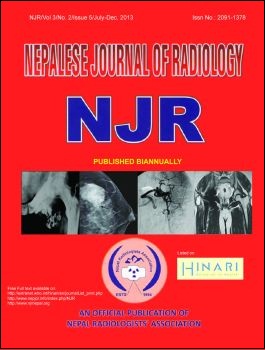The Role of Ultrasound in Ovulation Detection Compared To BBT and Other Methods
DOI:
https://doi.org/10.3126/njr.v3i2.9608Keywords:
Basal body temperature, Follicular monitoring, Ovulation detection, UltrasoundAbstract
Background: The detection of timing of ovulation is an important step in the evaluation and management of subfertility. Ultrasonography plays a vital role in monitoring follicular growth.
Aims: To assess the value of ultrasound scanning of the ovaries in the periovulatory period to detect ovulation and to correlate the results with basal body temperature (BBT) chart and other presumptive evidences of ovulation.
Methods: In this prospective study, a total of 60 subfertile patients were selected from the outpatient department of obstetrics and gynaecology, BPKIHS, Dharan. BBT charting, midcycle abdominal pain record & premenstrual endometrial biopsy were performed in all patients i.e. in spontaneous ovulating and anovulating (induced later). Ultrasonographic periovulatory follicular tracking was usually started around 10th day of the cycle. The results were then correlated with BBT mainly and also with mittelschmerz and endometrial biopsy.
Results: In this series fifty five patients, who demonstrated sixty ovulations (with failed inductions in five patients) were monitored for hundred ten cycles. The mean preovulatory follicular diameter was 20.55 mm and 21.76 mm in spontaneous and induced cycles respectively. Majority (36%) demonstrated ovulation by disappearance of follicles accompanied by increase in the amount of fluid in the pouch of Douglas (POD). In this study five cases (14.2%) out of thirty five showing biphasic BBT were anovulatoty. Whereas five cases out of twenty one showing monophasic BBT were ovulating. Amongst the inconclusive group, one (25%) patient was ovulating and the rest four (75%) were anovulatoty. Only 35% patients experienced midcycle pain. Ipsilateral pain was commoner (16.6%) than contralateral (6.6%) and central pain (11.6%).
Conclusion: Ultrasonographic follicular tracking is a reliable method of ovulation detection. Ovulation precedes the initial rise in temperature in most women confirming the limited value of the rise in BBT as a predictor of ovulation.
DOI: http://dx.doi.org/10.3126/njr.v3i2.9608
Nepalese Journal of Radiology Vol.3(2)July-Dec, 2013: 57-64
Downloads
Downloads
Published
How to Cite
Issue
Section
License
This license enables reusers to distribute, remix, adapt, and build upon the material in any medium or format, so long as attribution is given to the creator. The license allows for commercial use.




